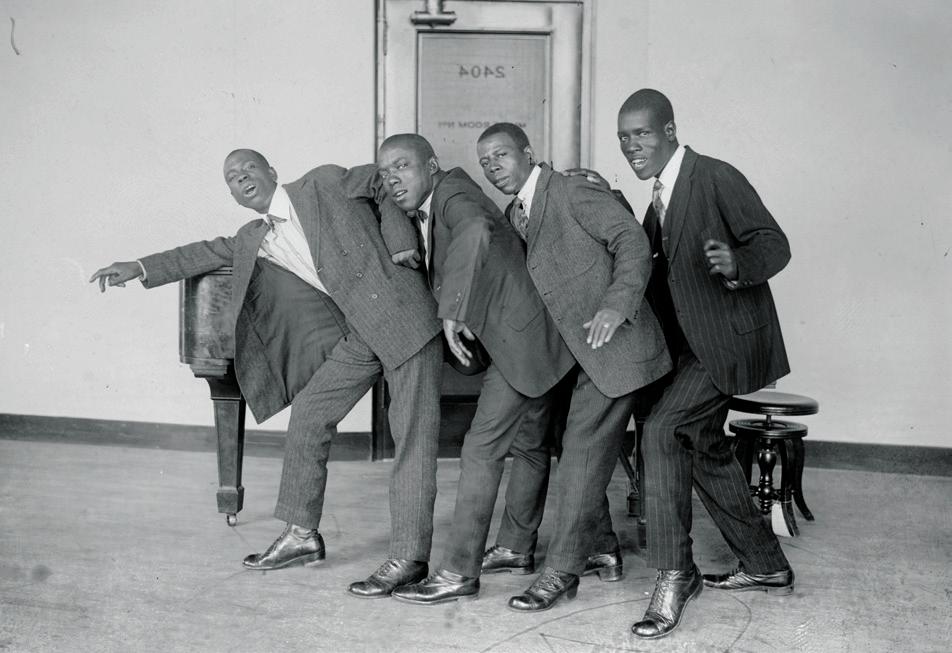
3 minute read
WHY THE 1920S?
By Jenny Roberts-Reilley Instruction Librarian, University of the Arts
When it came time for our Teaching with Primary Sources team to decide on a topic for this year’s guide, I was immediately drawn to an exploration of the 1920s. Why? For one thing, it’s the centennial - one hundred years since those “Roaring 20s.” Plus, what other decade in our nation’s history has such a fun and catchy nickname? Not to mention the treasure trove of 1920s primary sources now available in the public domain. In 2023, thousands of copyright works published before 1927 became free for all to copy, share, and build upon in new and creative ways; these primary sources offer excellent opportunities for students to flex their creative muscles. But the main reason I was excited by the topic is that I spent the past eight years teaching at a local public high school, where students seemed to love all things 20s. The 1920s was their most engaging unit in History class, produced one of their favorite books in English class (The Great Gatsby), and last year, was even their chosen prom theme.
Advertisement
I suppose the real question is: why have the 1920s captured their young imaginations so? Well, there’s the obvious draw of flappers, gangsters, bootleggers, and speak-easies. But perhaps in more recent years, director Baz Lurhmann can take a bit of the credit. His 2013 over-the-top film adaptation of Gatsby gave the classic staple of curriculum a “glowup,” ramping up the luxury and frivolity, and infusing it with modern-day hip-hop tracks. Luhrmann did so with intention, collaborating with rapper and producer Jay-Z. A New York Times article quoted Luhrman as saying “hip-hop now is what jazz was then”; he “wanted audiences to feel the excitement that readers would have felt in the 20s.” Success! Now that they’re hooked, we can go deeper. The 20s weren’t all glitz and glam and rich white people at extravagant parties after all. There is an array of diverse experiences to explore. Take a close look at the Black communities that led the way, creatively and culturally, into this new “jazz age.” Consider the experiences of the jazz musician in Chicago, the Cotton Club dancer in Harlem, the follower of Marcus Garvey, the sharecropper in the South, a family moving North during The Great Migration, and many more. Through an exploration of primary sources, our students are provided with windows into the lives of these marginalized voices from a century ago.
It may interest students to know that the 1920s saw the very first national youth rebellion. What could be more relatable?! Students can view this legendary decade through the experiences of young people and ponder why they felt compelled to rebel. A college grad and future journalist, John F. Carter Jr. explained in the September 1920 issue of Atlantic Monthly: “the older generation had certainly pretty well ruined this world before passing it on to us. They give us this
Thing, knocked to pieces, leaky, red-hot, threatening to blow up; and then they are surprised that we don’t accept it with the same enthusiasm with which they received it.” The first World War had just ended and so many young people had served and died. It was time to “seize-the-day” and enjoy life. Social and cultural norms were rapidly changing and the youth were leading the way. Can students today relate? I should say so.
The 1920s has numerous historical similarities to todaya contentious presidential election right on the heels of a catastrophic global pandemic while sociopolitical polarization grew and violence flared. Of course, it was a very exciting time for the arts. The Harlem Renaissance was just beginning, ushering in The Jazz Age, named for the free, rebellious music with syncopated rhythms that Black artists were cultivating. Jazz influenced everything from dance to fashion to literature and reflected the spirit of the time. If hip-hop is the jazz of today, then podcasts are the radio broadcasts and Tik-Tok dance challenges are the silent films (action set to music) and popular dance crazes. All of these modes of communication are opportunities to connect the past to the present and ignite student curiosity and creativity. And don’t forget the amazing works already in the public domain for students to build upon. Could they write and film a new scene for an old Buster Keaton film? Design a new building borrowing features of Art Deco architecture? Craft poetry and writing in the style of Hughes, Hurston, or McKay? Produce a podcast to parody a 1920s radio broadcast? The creative possibilities are endless!
What can the past teach us about our present moment?
By acting as historians or “history detectives” and analyzing and engaging with primary sources from 100 years ago, students can both relate to and learn from the past, preparing them to meet the challenges of today and tomorrow.
References:
Bowen, E. (Ed.). (1969). This fabulous century: 1920-1930. Time-Life Books. McGrath, C. (2013, May 3). An orgiastic ‘Gatsby’? Of course. New York Times https://www.nytimes.com/2013/05/05/movies/baz-luhrmann-adds-3-dand-hip-hop-to-the-great-gatsby.html









